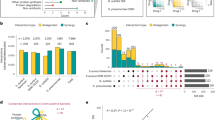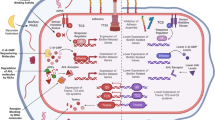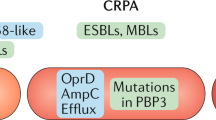Key Points
-
Antimicrobial pharmacodynamics attempts to link measures of drug exposure to the observed effect. This differs from other areas of pharmacodynamics because the main indicator of effect and the site of action of the drug is the organism that causes the pathological process.
-
Understanding antimicrobial pharmacodynamics requires the acceptance of four important ideas. First, the drug exposure achieved with a fixed drug dose varies greatly in the infected population of interest. Second, the shape of the concentration–time curve can sometimes affect the outcome. Third, only non-protein-bound drug is microbiologically active. Finally, as the measure of potency increases, the effect any fixed drug dose will cause decreases.
-
All these ideas can be integrated by use of the Monte Carlo simulation to determine the potential use of a drug and dose for the intended population and to estimate susceptibility breakpoints.
-
These techniques can also be used to help suppress the amplification of resistant subpopulations by identifying the drug exposure that will cause this effect and then evaluating the use of different doses for attaining the exposure target in the population of interest.
-
These ideas can be transferred to the clinical arena. The use of optimal sampling techniques allows informative times for blood sample acquisition to be identified. Population modelling followed by Bayesian estimation allows robust estimation of the exposure achieved in a specific patient. Exposure measures relative to the MIC of the pathogen (peak/MIC ratio, AUC/MIC ratio and time > MIC) can then be linked to the desired clinical or microbiological outcome through common statistical techniques, such as logistic regression analysis, classification and regression tree (CART) analysis and Cox proportional hazards modelling.
Abstract
Antimicrobial pharmacodynamics is the discipline that integrates microbiology and pharmacology, with the aim of linking a measure of drug exposure, relative to a measure of drug potency for the pathogen in question, to the microbiological or clinical effect achieved. The delineation of such relationships allows the drug dose to be chosen in a rational manner, so that the desired effect (for example, the maximal bactericidal effect) can be achieved in a large proportion of the intended patient population. Ultimately, the goal of any anti-infective therapy is to administer a dose of drug that has an acceptably high probability of achieving the desired therapeutic effect balanced with an acceptably low probability of toxicity. Appropriate use of the latest pharmacodynamic modelling approaches can minimize the emergence of resistance and optimize the outcome for patients.
This is a preview of subscription content, access via your institution
Access options
Subscribe to this journal
Receive 12 print issues and online access
$209.00 per year
only $17.42 per issue
Buy this article
- Purchase on Springer Link
- Instant access to full article PDF
Prices may be subject to local taxes which are calculated during checkout







Similar content being viewed by others
References
Preston, S. L. et al. Pharmacodynamics of levofloxacin: a new paradigm for early clinical trials. JAMA 279, 125–129 (1998). The first prospective multicentre clinical trial recognized by the FDA as describing the development of a pharmacodynamic relationship for a clinical and microbiological outcome.
Preston, S. L. et al. Levofloxacin population pharmacokinetics and creation of a demographic model for prediction of individual drug clearance in patients with serious community-acquired infection. Antimicrob. Agents Chemother. 42, 1098–1104 (1998).
Chien, S. -C. et al. Pharmacokinetic profile of levofloxacin following once-daily 500-milligram oral or intravenous doses. Antimicrob. Agents Chemother. 41, 2256–2260 (1997).
Eagle, H., Fleischman, R. & Levy, M. Continuous versus discontinuous therapy with penicillin: the effect of interval between injections on therapeutic efficacy. N. Engl. J. Med. 248, 481–488 (1953). The first animal infection study in which pharmacodynamic principles were used.
Vogelman, B. et al. Correlation of antimicrobial pharmacokinetic parameters with therapeutic efficacy in an animal model. J. Infect. Dis. 158, 831–847 (1988).
Fluckiger, U., Segessenmann, C. & Gerber, A. U. Integration of pharmacokinetics and pharmacodynamics of imipenem in a human-adapted mouse model. Antimicrob. Agents Chemother. 35, 1905–1910 (1991).
Craig, W. A., Redington, J. & Ebert, S. C. Pharmacodynamics of amikacin in vitro and in mouse thigh and lung infections. J. Antimicrob. Chemother. 27 (Suppl.) S29–S40 (1991).
Andes, D. & Craig, W. A. Pharmacodynamics of the new fluoroquinolone gatifloxacin in murine thigh and lung infection models. Antimicrob. Agents Chemother. 46, 1665–1670 (2002).
Craig, W. A. Pharmacokinetic/pharmacodynamic parameters: rationale for antibacterial dosing of mice and men. Clin. Infect. Dis. 26, 1–12 (1998). A summary of much early animal work in pharmacodynamics.
Craig, W. A. Does the dose matter? Clin. Infect. Dis. 33, (Suppl.) S233–S237 (2001).
Craig, W. A. Basic pharmacodynamics of antibacterials with clinical applications to the use of β-lactams, glycopeptides and linezolid. Infect. Dis. Clin. North Am. 17, 479–501 (2003).
Eagle, H. & Musselman, A. D. The slow recovery of bacteria from the toxic effects of penicillin. J. Bacteriol. 58, 475–490 (1949).
Williamson, R. & Tomasz, A. Inhibition of cell wall synthesis and acylation of the penicillin binding proteins during prolonged exposure of growing Streptococcus pneumoniae to benzylpenicillin. Eur. J. Biochem. 151, 475–483 (1985).
Odenholt-Tornqvist, I., Lowdin, E. & Cars, O. Pharmacodynamic effects of subinhibitory concentrations of β-lactam antibiotics in vitro. Antimicrob. Agents Chemother. 35, 1834–1839 (1991).
Merriken, D. J., Briant, J. & Rolinson, G. N. Effect of protein binding on antibiotic activity in vivo. J. Antimicrob. Chemother. 11, 233–238 (1983).
Bilello, J. A. et al. The uptake and anti-HIV activity of A-80987, an inhibitor of the HIV-1 protease, is reduced by human serum 1-acid glycoprotein. Antimicrob. Agents Chemother. 40, 1491–1497 (1996).
Drusano, G. L., Johnson, D. E., Rosen, M. & Standiford, H. C. Pharmacodynamics of a fluoroquinolone antimicrobial in a neutropenic rat model of Pseudomonas sepsis. Antimicrob. Agents Chemother. 37, 483–490 (1993).
Andes, D. & Craig, W. A. Pharmacodynamics of the new fluoroquinolone gatifloxacin in murine thigh and lung infection models. Antimicrob. Agents Chemother. 46, 1665–1670 (2002).
US Food and Drug Administration. Meeting of the Food and Drug Administration Advisory Committee for the Division of Anti-Infective Drug Products. [online], <http://www.fda.gov/ohrms/dockets/ac/cder98t.htm> (15 October 1998).
Drusano, G. L. et al. Use of preclinical data for the choice of a Phase II/III dose for evernimicin with application to decision support for identification of a preclinical MIC breakpoint. Antimicrob. Agents Chemother. 45, 13–22 (2001). Describes the use of the Monte Carlo simulation as a method for evaluating the use of drug doses for populations and as a method for setting susceptibility breakpoints.
Drusano, G. L. et al. Hollow fiber unit evaluation of a new human immunodeficiency virus (HIV)-1 protease inhibitor, BMS 232632, for determination of the linked pharmacodynamic variable. J. Infect. Dis. 183, 1126–1129 (2001).
Drusano, G. L., Moore, K. H. P., Kleim, J. P., Prince, W. & Bye, A. Rational dose selection for a non-nucleoside reverse transcriptase inhibitor through the use of population pharmacokinetic modeling and Monte Carlo simulation. Antimicrob. Agents Chemother. 46, 913–916 (2002).
Dudley, M. N. & Ambrose, P. G. Monte Carlo PK-PD simulation and new cefotaxime, ceftriaxone, and cefipime susceptibility breakpoints for S. pneumoniae, including strains with reduced susceptibility to penicillin. Abstract A-1263, 42nd Interscience Conference on Antimicrobial Agents and Chemotherapy, San Diego, California (2002).
Ambrose, P. G., Craig, W. A., Bhavnani, B. M. & Dudley, M. N. Pharmacodynamic comparisons of different dosing regimens of penicillin G against penicillin-susceptible and -resistant pneumococci. Abstract A-635, 42nd Interscience Conference on Antimicrobial Agents and Chemotherapy, San Diego, California (2002).
Jumbe, N. et al. Application of a mathematical model to prevent in vivo amplification of antibiotic-resistant bacterial populations during therapy. J. Clin. Invest. 112, 275–285 (2003). The first demonstration that it is possible to delineate a drug exposure that would prevent the amplification of mutant subpopulations, together with a prospective validation.
Forrest, A. et al. Pharmacodynamics of intravenous ciprofloxacin in seriously ill patients. Antimicrob. Agents Chemother. 37, 1073–1081 (1993).
Feldman, C. et al. The presence and sequence of endotracheal tube colonization in patients undergoing mechanical ventilation. Eur. Resp. J. 13, 546–551 (1999).
Friedland, D. R., Rothschild, M. A., Delgado, M., Isenberg, H. & Holzman, I. Bacterial colonization of endotracheal tubes in intubated neonates. Arch. Otolaryngol. Head Neck Surg. 127, 525–528 (2001).
Tam, V. H., Preston, S. L. & Drusano, G. L. Optimal sampling schedule design for populations of patients. Antimicrob. Agents Chemother. 47, 2888–2891 (2003).
Ambrose, P. G. et al. Pharmacodynamics of fluoroquinolones against Streptococcus pneumoniae in patients with community-acquired respiratory tract infections. Antimicrob. Agents Chemother. 45, 2793–2797 (2001).
Forrest, A., Chodosh, S., Amantea, M. A., Collins, D. A. & Schentag, J. J. Pharmacokinetics and pharmacodynamics of oral grepafloxacin in patients with acute bacterial exacerbations of chronic bronchitis. J. Antimicrob. Chemother. 40 (Suppl.), A45–A57 (1997).
Drusano, G. L. et al. The relationship between fluoroquinolone AUC/MIC ratio and the probability of eradication in patients with nosocomial pneumonia. J. Infect. Dis. (in the press).
Kashuba, A. D., Nafziger, A. N., Drusano, G. L. & Bertino, J. S. Jr. Optimizing aminoglycoside therapy for nosocomial pneumonia caused by Gram-negative bacteria. Antimicrob. Agents Chemother. 43, 623–629 (1999).
Tam, V. H., McKinnon, P. S., Akins, R. L., Rybak, M. J. & Drusano, G. L. Pharmacodynamics of cefepime in patients with Gram-negative infections. J. Antimicrob. Chemother. 50, 425–428 (2002).
Sheiner, L. B., Rosenberg, B. & Marathe, V. V. Estimation of population characteristics of pharmacokinetic parameters from routine clinical data. J. Pharmacokinet. Biopharm. 5, 445–479 (1977).
D'Argenio, D. Z. Optimal sampling times for pharmacokinetic experiments. J. Pharmacokinet. Biopharm. 9, 739–756 (1981).
D'Argenio, D. Z. Incorporating prior parameter uncertainty in the design of sampling schedules for pharmacokinetic parameter estimation experiments. Math. Biosci. 99, 105–118 (1990).
Tod, M. & Rocchisani, J. -M. Implementation of OSPOP, an algorithm for the estimation of optimal sampling times in pharmacokinetics by the ED, EID and API criteria. Comput. Methods Programs Biomed. 50, 13–22 (1996).
Leary, R., Jelliffe, R., Schumitzky, A. & van Guilder, M. in Proceedings of the 14th IEEE Symposium on Computer-Based Medical Systems 389–394 (IEEE Computer Society, Bethesda, Maryland, July 2001).
Mallet, A., Mentre, F., Steimer, J. L. & Lokiec, F. Non-parametric maximum likelihood estimation for population pharmacokinetics, with application to cyclosporine. J. Pharmacokinet. Biopharm. 16, 311–327 (1988).
Chow, A. T. et al. Safety and pharmacokinetics of multiple 750-milligram doses of intravenous levofloxacin in healthy volunteers. Antimicrob. Agents Chemother. 45, 2122–2125 (2001).
Sheiner, L. B., Beal, S., Rosenberg, B. & Marathe, V. V. Forecasting individual pharmacokinetics. Clin. Pharmacol. Ther. 26, 294–305 (1979).
Drusano, G. L. et al. Factors influencing the emergence of resistance to indinavir: role of virologic, immunologic, and pharmacologic variables. J. Infect. Dis. 178, 360–367 (1998).
Drusano, G. L. et al. Relationship between foscarnet exposure, baseline cytomegalovirus blood culture and the time to progression of cytomegalovirus retinitis in HIV-positive patients. AIDS 10, 1113–1119 (1996).
Craig, W. A. & Ebert, S. C. Continuous infusion of β-lactam antibiotics. Antimicrob. Agents Chemother. 36, 2577–2583 (1992).
Drusano, G. L. Prevention of resistance: a goal for dose selection for antimicrobial agents. Clin. Infect. Dis. 36 (Suppl.) S42–S50 (2003).
Mouton, J. W., Dudley, M. N., Cars, O., Derendorf, H. & Drusano, G. L. Standardization of pharmacokinetic/pharmacodynamic (PK/PD) terminology for anti-infective drugs. Int. J. Antimicrob. Agents 19, 355–358 (2002).
Acknowledgements
The author benefitted from insightful discussions with F. Bloom.
Author information
Authors and Affiliations
Ethics declarations
Competing interests
The author declares no competing financial interests.
Related links
Related links
DATABASES
Entrez
FURTHER INFORMATION
European Agency for the Evaluation of Medicinal Products
International Society of Anti-infective Pharmacology
Glossary
- PHARMACODYNAMICS
-
The study of the biochemical and physiological effects of drugs and the mechanisms of their actions.
- MINIMAL INHIBITORY CONCENTRATION
-
(MIC). The lowest drug concentration that results in stasis.
- EFFECTIVE CONCENTRATION90
-
(EC90). Usually applied to virus susceptibility — the drug concentration resulting in a decrease in replication of 90%.
- PHARMACOKINETIC
-
The study of the bodily absorption, distribution, metabolism and excretion of drugs.
- DRUG CLEARANCE
-
The volume of plasma that is completely cleared of drug per unit time.
- VOLUME OF DISTRIBUTION
-
The apparent volume in the patient relating dose and observed plasma concentration.
- AREA UNDER THE CONCENTRATION–TIME CURVE
-
(AUC). A measure of the total exposure to drug — the integral of the concentration–time curve.
- PEAK CONCENTRATION
-
The highest concentration attained in a dosing interval.
- TIME > MIC
-
The time that drug concentrations exceed the MIC, often stated as a percentage of the dosing interval.
- BACTERIOSTATIC
-
An antibiotic that inhibits the growth of a bacterial population.
- BACTERICIDAL
-
An antibiotic that kills 99.99% of a bacterial population.
- AUC/MIC
-
Ratio of the area under the concentration–time curve to the MIC.
- POST-ANTIBIOTIC EFFECT
-
(PAE). Persistent inhibitory effect on a microorganism that results from drug exposure after the drug has been completely removed.
- POST-ANTIBIOTIC SUB-MIC EFFECT
-
(PA-SME). Persistent inhibitory effect on a microorganism that results from drug exposure after the drug has been diluted to a fraction of the MIC.
- PROTECTIVE DRUG DOSE
-
(PD50 or CD50). The drug dose resulting in protection of 50% of challenged animals.
- PEAK CONCENTRATION/MIC
-
The ratio of the peak concentration to the MIC.
- GRANULOCYTOPENIC
-
A blood disorder that is characterized by a severe reduction in the number of granulocytes in blood.
- NEUTROPENIC
-
An abnormal decrease in the number of white cells in the blood.
- MONTE CARLO SIMULATION
-
An analytical technique for solving a problem by performing a large number of simulations and inferring a solution from the collective results that can be used to calculate the probability distribution of possible outcomes.
Rights and permissions
About this article
Cite this article
Drusano, G. Antimicrobial pharmacodynamics: critical interactions of 'bug and drug'. Nat Rev Microbiol 2, 289–300 (2004). https://doi.org/10.1038/nrmicro862
Issue Date:
DOI: https://doi.org/10.1038/nrmicro862
This article is cited by
-
Target attainment and population pharmacokinetics of flucloxacillin in critically ill patients: a multicenter study
Critical Care (2023)
-
Mixed strain pathogen populations accelerate the evolution of antibiotic resistance in patients
Nature Communications (2023)
-
Optimization of β-Lactam Dosing Regimens in Neonatal Infections: Continuous and Extended Administration versus Intermittent Administration
Clinical Pharmacokinetics (2023)
-
Population Pharmacokinetics of Piperacillin/Tazobactam Across the Adult Lifespan
Clinical Pharmacokinetics (2023)
-
The effect of a loading dose of meropenem on outcomes of patients with sepsis treated by continuous renal replacement: study protocol for a randomized controlled trial
Trials (2022)



